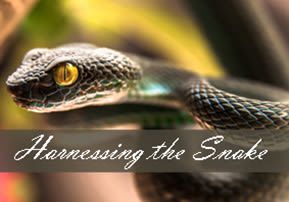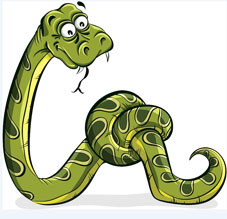
Ki Tavo: Harnessing the Snake
The killing done by the snake that has no particular benefit. This parallels those nations that kill and destroy without any direct gain.

This week's reading usually coincides with the end of the Jewish year. Jews are often familiar with the parsha's words "may the curses of last year finish, and may we start the new one with blessings". The reason for this well-wishing is that the reading of Ki Tavo relates the curses and calamities that will befall the Jewish people if we don't follow the words of Hashem.
We all know too well to what degree these words have been fulfilled during our long sojourn through history. In particular, these horrors were realized just seventy years ago by the accursed Nazis whose cruelty and sadism knew no bounds.
Yet, in the midst of that nightmare, many Jews maintained their connection with Hashem and His Torah. One of those remarkable heroes was Rabbi Klonimus Kalman Shapira, who lead his congregation in the Warsaw ghetto under the most horrific conditions. While still in the ghetto he wrote his insights on the weekly Torah reading. He buried them and they were miraculously discovered in the rubble of the ghetto after the war. They were republished and remain a remarkable testimony to the eternity of our people and to their connection and love of the Torah. His insights, written in the mouth of the dragon, speak volumes of his personal clarity during the darkness. I pray I do justice to his holy words.
The Talmud tells us cryptically: "Woe to us that the snake was cursed at the time of Adam and Eve. For had he not been cursed each one of us would have had two snakes serving him, bringing precious jewels and  diamonds from far and wide." What is the meaning of this statement? Why is the snake the one who would have brought us such gifts? Couldn't other animals also have delivered us these treasures?
diamonds from far and wide." What is the meaning of this statement? Why is the snake the one who would have brought us such gifts? Couldn't other animals also have delivered us these treasures?
The Jerusalem Talmud relates a dialogue between the snake and other members of the animal kingdom. The lion asks the snake what purpose he has in biting others. The lion explains that his own motivations are in order to provide for himself and his family but he accuses the snake of killing for no apparent reason. The snake replies that he too has a reason although less direct. He says that he simply is an agent of Hashem and he bites whomever Hashem decrees should be bitten.
This story also needs clarification. What is meant by this dialogue? What were our Sages trying to teach us in this interchange?
Rabbi Shapira explains that there are two types of damagers in this world. One that is natural and the other, unnatural. It is natural that a lion kills in order to eat. That is something we expect of animals and it even could be understood in relation to people who kill in order to protect themselves or even to conquer others. But there's a second type of damage which isn't rational, the killing done by the snake that has no particular benefit. This parallels those nations that kill and destroy without any direct gain. The Nazis were the snakes of recent history. They killed and maimed, much like the snake, without any tangible benefit. Their fury was unnatural and they were given permission to sink their fangs into millions of men, women, and children. And in a certain way what they did could actually be called miraculous. Miraculously terrible undoubtedly, but miraculous nonetheless.
(Parenthetically I have traveled numerous times to Poland to see the Concentration Camps. There is nothing natural about what one witnesses there.)
So according to the story in the Jerusalem Talmud, the Rabbis are trying to teach us about an animal and a reality that represents a type of destruction that was personified in a snake-like nation seventy years ago. In order to understand our original quote we need to keep in mind that such ruthless destruction is on a certain level miraculous since it defies the laws of nature and reason. However, is this type of miracle limited to evil? The first statement mentioned above relates to mankind's loss that the snake was cursed. The snake was a creature that wasn't necessarily destined for evil. In fact, it seems that he could have been the harbinger of goodness, even miracles. Had the snake not been cursed it would have been a supernatural creature dedicated to man's service, but instead he became the symbol of unnatural and wanton destruction.
Here Rabbi Shapira says something truly remarkable. He says that the Nazis were dedicated to an unnatural, miraculously evil ideology. But if the Jews had prayed and returned to Hashem those same miraculous qualities could have a positive expression. If the Jewish people do not strengthen themselves, we are witness to the curses mentioned in this week's readings. Conversely, a change in attitude and action on our parts cause the very same accursed snake to bring us jewels and diamonds.
Using what seemed like two strange metaphors, the Sages are teaching us the nature of evil and its ability to be turned into blessing. Seventy years ago we witnessed evil personified and unfortunately at this very time we see nations who, with a vengeance, are still trying to inject their venom into the Jewish people. We can use the insights of Rabbi Shapira as inspiration for us today. Even in those demonic times he saw the possibility of a complete turn-about, that the very source of the miracles of evil could become the potential for miracles of blessing. May we merit to see the same people who exhibit an unnatural hatred towards the Jewish people become the source of unimagined blessing very soon.











9/03/2020
Harnessing the snake…once upon a time, I read an article by the New York Times, about a prominent, Jewish personalitiy saying that "….after the Holocaust, the Jewish people only could count on themselves…" I felt pain in the heart to read this, because, I knew , even I didn't understand his words, God never abandon us, as you keep remembering in the middle of such obscurity, Jewish kept ligtening in a most powerful ways.